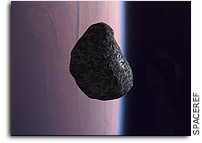Texas State research sheds new light on panspermia

When the space shuttle Columbia broke apart during reentry Feb. 1, 2003, more than 80 on-board science experiments were lost in the fiery descent.
Texas State University-San Marcos biologist Robert McLean, however, has salvaged some unexpected science from the wreckage. A strain of slow-growing bacteria survived the crash, a discovery which may have significant implications for the concept of panspermia. The findings will be published in the May 2006 issue of Icarus, the international journal of solar system studies.
Panspermia is the idea that life–hitchhiking on rocks ejected from meteorite impacts on one world–could travel through space and seed other worlds with life under favorable conditions. Because the conditions under which panspermia could function are so harsh, however, there’s been little direct testing of the hypothesis.
“That might have been in the back of my mind when we recovered our payload,” McLean said. McLean, along with a team of Texas State researchers, had placed an experiment package aboard the Columbia to investigate the interactions of three different bacterial species in microgravity. When the shuttle broke up over Texas, they assumed the experiment lost–until it turned up, relatively intact, in the parking lot of a Nacogdoches convenience store. “My first thinking when we found our payload was, ‘Let’s look for survivors.'”
And survivors he found–a bacteria called Microbispora. Ironically, Microbispora wasn’t one of the three species McLean expected to find. The slow-growing organism is normally found in the soil, and McLean determined that it had contaminated the experiment prior to launch. With the Icarus publication, McLean anticipates request for samples of this rugged strain to come in from researchers around the world.
“This organism appears to have survived an atmospheric passage, with the heat and the force of impact,” he said. “That’s only about a fifth of the speed that something on a real meteorite would have to survive, but it is at least five or six times faster than what’s been tested before.
“This is important for panspermia, because if something survives space travel, it eventually has to get down to the Earth and survive passage through the atmosphere and impact. This doesn’t prove anything–it just contributes evidence to the plausibility of panspermia. Realistically, that’s all it can do,” McLean said. “Out of respect for the seven people who gave their lives for this research, I feel it’s very important these results don’t get lost.”









